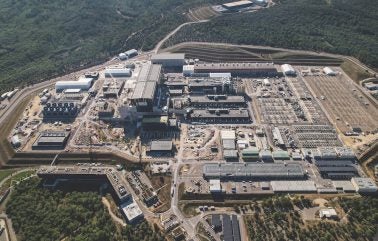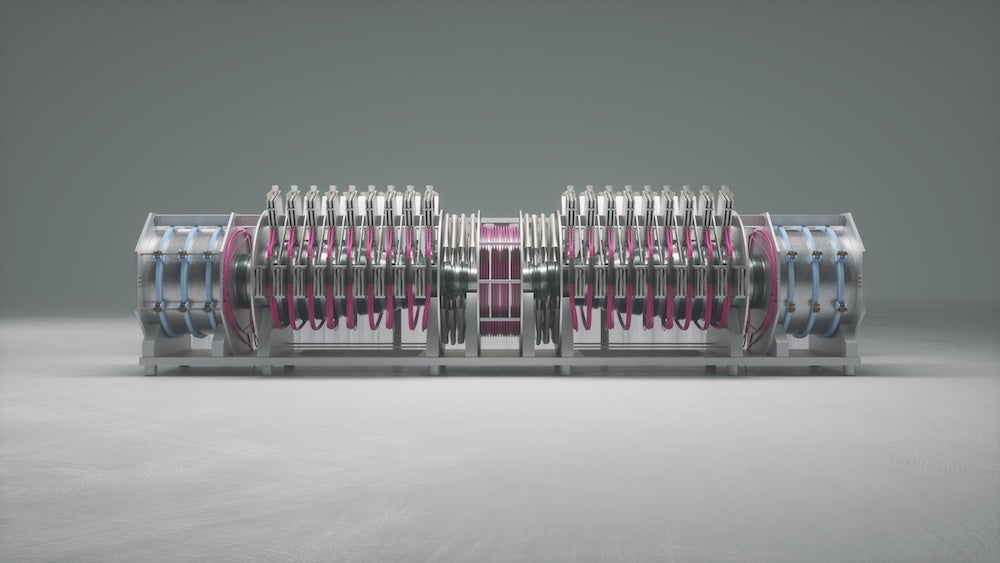
A recent visit to the Max Planck Institute for Plasma Physics prompted European Commission president Ursula von der Leyen to emphasise the need for a European fusion alliance, public-private partnership programmes, and a clear regulatory framework. Her words reinforced the growing sentiment that fusion is an energy technology that will soon finally deliver on its long-held promise as a viable clean energy resource.
“We will indeed need a lot more energy in the future. We need it to be clean and we need it to be safe, and nuclear fusion can provide that. So, we need to invest in this and, above all, to advance the research,” said von der Leyen. She went on to note that while fusion is one of the most complex tasks that science has ever faced, Europe is a global leader in fusion research. “We want to keep this leadership position,” she said, adding that Europe needs to invest more in fusion research to do so.
“We still need to significantly improve the framework conditions so that we can become faster and more effective. We need to promote more public-private research partnerships,” she said, noting that a lot more investment is required to fund technology companies helping to fill gaps. “Secondly, we also need to encourage industry to invest, as it is already doing, but to invest even more in fusion technology.” von der Leyen stated that the Capital Markets Union must also be advanced to make it possible for companies to gain access to growth capital. “When we have deepened and completed the Capital Markets Union, there will be €500bn more in investment opportunities per year,” she said, before adding: “We need to advance fusion technology, but we also need to make sure that it can make its way out of the laboratory onto the market and become a better business case,” she said.
Although the European Union already supports fusion through the Euratom research and training programme and through ITER – with €5.6bn earmarked for this international project in the current EU budget – von der Leyen’s comments follow on from the publication of a new independent report the European Commission (EC) has published and which analyses the possibility of fostering public-private partnerships to encourage investment and innovation in fusion technology.
The report notes that, up until now, EU fusion financing primarily featured public bodies investing huge sums in big projects. At the same time, it says, industry has tended to take a much more passive role. The authors note that the private sector only becomes active once contracts for procuring services or components have been issued.
The report warns that while Europe has had a leading role in fusion research globally, as host to the ITER project for example – and has thus also made a major contribution to fusion innovation, the industry supply chain, and research – there is a significant risk. The report’s authors argue that EU fusion know-how and industrial potential might be lost with innovation investments declining as
ITER nears completion. This is expected to take place in the context of similar investments for DEMO, the DEMOnstration power plant and successor to ITER, remaining more than a decade away. Furthermore, the authors note, international competition is increasing with new public investment in fusion in other countries as a vibrant private sector is also emerging. There are concerns that both of these factors may attract investments and expertise away from the EU.
However, the EC is looking at developing a new strategic long-term approach and the report forms part of that move. This approach would entail fostering public-private partnerships in a bid to prioritise innovation and close technological gaps, while also enhancing industrial investment and technology transfer.
Key EU PPP funding mechanisms
Given there is growing recognition that promoting a faster and viable commercialisation of fusion energy will require both public and private investment and that neither public investment nor private enterprise will be able to achieve it alone, a public-private partnership model has been mooted as a solution.
The report details the current EU funding landscape, noting that whilst hundreds of millions of Euro are invested in ITER and related activities such as Broader Approach, IFMIF-DONES, as well as EUROfusion which is focused on scientific research, other instruments in the EU research and innovation funding landscape are either not yet active for fusion or not yet appropriate due to the low level
of technological maturity in many areas. For example, whilst there are EU funding possibilities under Horizon Europe, including Partnership approaches, no fusion relevant programme exists. Other instruments such as the Innovation Fund and Breakthrough Energy Catalyst could also be opportunities, but these have a focus on more mature technologies.

Based on an analysis of leading public-private partnership schemes, the report’s recommendations to the EC are that establishing a public-private partnership approach to support industrial innovation in the EU should be considered. It further recommends the EC pursue public- private partnership arrangements in parallel through three instruments – a Co-Programmed European Partnership, F4E Innovation Partnerships and the EIT-KIC InnoEnergy scheme.
Each of these approaches address different needs and are complementary with the overall goal of contributing to future design and development, maintaining EU industrial know-how and competitiveness, and leveraging EU scientific leadership and the ITER project.
According to the report, Co-Programmed European Partnership (CPEP) are assessed as the most relevant and interesting for an EU fusion PPP mechanism and derive from the main Horizon Europe research partnership approaches.
The report’s authors note that a CPEP is a partnership between the EC and usually private, but sometimes also public, partners and is an approach that would therefore accommodate both industrial and research partners. Intended to provide the critical mass necessary to pursue solutions to European or global challenges, they recommend that CPEPs should have a life-cycle approach but be limited in time with conditions for phasing out funding.
Funding for CPEPs is substantial, with hundreds of millions of public funding provided for each existing CPEP. However, the private sector is expected to at least match every euro invested by the EU, though these contributions can be in-kind contributions. Private partners in a CPEP are also obliged to carry out additional activities within the CPEP. These activities should be part of the Strategic Research and Innovation Agenda (SRIA) but not funded by Horizon Europe and thus only self-funded, demonstrating a commitment to the innovation agenda.
Referring to the European Institute of Innovation and Technology Knowledge and Innovation Communities (EIT/KIC), the report identifies these nine established, cross-disciplinary partnerships set up by the EU to foster innovation, entrepreneurship, and knowledge exchange, recognising them as a form of Institutionalised Partnership and an alternative under Horizon Europe. The authors observe that Horizon Europe has already funded one fusion start-up – Novatron Fusion – through its InnoEnergy KIC programme and could potentially also support further industrial innovation.
EIT/KIC will receive almost €3bn in funding between 2021-2027 while InnoEnergy is the leading KIC dedicated to fostering innovation in sustainable energy technologies. Bringing together academia, industry, and entrepreneurs to accelerate Europe’s energy transition to a low-carbon energy future, it was allocated EUR 44 million for 2023 and 2024.
While currently InnoEnergy has three focus areas – battery storage, green hydrogen and solar PV – the authors suggest that given its potential significance and multidisciplinary nature, a distinct fusion energy category could potentially be introduced under EIT InnoEnergy, to support and accelerate innovation, research, and commercialisation efforts.
Under an InnoEnergy grant a maximum of 45.55% of costs can be funded, with matching contributions required from partners, which again can take the form of in-kind contributions.
Turning to F4E, the report considers that it has a crucial role in the EU fusion ecosystem, particularly linked to ITER, but also broader objectives and policies. The authors argue that the platform provides the basis for it to play an expanded role in industrial development or even developing a demonstration power plant. The report notes that F4E already employs more than 400 people within an administrative, financial and technical infrastructure, as well as boasting close ties with the industry. As a result, it could be well positioned to play a role in a future EU PPP given funding could be channelled directly to industrial innovation.
The objectives of F4E include DEMO and thus the scope covers the full range of enabling technologies for magnetic confinement-based fusion, the report says.
Building PPPs
It is clear that the EU wants to encourage innovation to maintain its competitiveness in the global fusion sector but to do so will require additional funding instruments. Analysis of the existing landscape identifies clear gaps and the report notes that a PPP-type mechanism instrument is the preferred measure to bridge those gaps. However, alongside EU-wide approaches, individual nations are also looking at PPPs to boost fusion funding.
Last year, for instance, Germany launched a new fusion research funding programme with the goal of building the country’s first fusion power plant by 2040. With the first phase focused on technologies, components, and materials with a view for readiness by the early 2030s, the second phase aims to integrate those into a power plant design. Open to multiple fusion technologies, including both magnetic and inertial confinement, the programme is based on collaborative public-private partnerships with research institutions, universities, and industry.
While Germany has decisively stepped away from nuclear fission it plans to increase fusion research funding to more than €1bn by 2028 with an additional €370m to be invested over the next four years and up to €100m a year available to fusion companies. Backed by the Federal Ministry of Education and Research (BMBF), the plan will also use the Federal Agency for Disruptive Innovation (SPRIND) to establish the Pulsed Light Technologies GmbH subsidiary to administer some of the funding for laser innovation and inertial fusion.

The report also argues that, as an alternative to CPEP, F4E Innovation Partnerships and the EIT-KIC InnoEnergy scheme, a completely new instrument could also be considered. For example, the authors say, one option could be for the EC to take on the role of founding a PPP vehicle directly or create a separate legal entity for the purpose of creating a PPP, as modelled by the German SPRIND programme. Alternatively, the report considers that other models from the US or from the UK could be emulated. However, this is not recommended in the report due to the need for urgency and the flexibility of existing instruments to be characterised in the same way as US and UK programmes.
Overall, the report concludes, it is much easier and faster to use an existing mechanism which include many of the benefits that a new instrument could bring.
Meanwhile, in the US the 2024 Appropriations bill will increase fusion R&D funding to $790m through the Department of Energy’s Office of Fusion Energy Sciences. The funding package includes significant growth in funding for PPP, with up to $40m more going to the programme which had received $25 million in each of the last two budgets. This PPP programme is currently investing in eight fusion companies. Separately, inertial fusion research received $690 million through the National Nuclear Security Administration (NNSA). Collectively, the US is pumping $1.48bn into fusion this year, a record.
More recently, the US has forged another partnership, this time working with Japan to accelerate commercialisation of fusion technologies. The bilateral agreement aims to build on fusion initiatives from both countries, such as Japan’s Fusion Energy Innovation Strategy, and will focus on a range of measures including opportunities for shared access and possible shared development of fusion research facilities, as well as harmonisation of regulatory frameworks.
The growing commitment of the private sector to fusion research, development and commercialisation is also worthy of note.
According to the Fusion Industry Association’s Global Fusion Industry Report in 2023, not only is the number of private companies investing in fusion growing, but overall investment went up again too. Their analysis found that the fusion industry has now attracted over $6bn in investment, an increase of $1.4bn on the previous year. The report shows that 27 companies increased their funding over the year with total fusion investment up by 27%. The FIA notes this took place during a period of inflation pressures, interest rate increases, and even bank failures, although much of this funding went to early-stage companies and in broadly smaller amounts. However, the report notes that funding for fusion companies totalled $6.2 bn of which $5.9bn came from the private sector and just $271m came from public funding sources. Even so, their industry survey found that 25 companies think the first fusion plant will deliver electricity to the grid before 2035, representing a clear opportunity for the industry. There’s no doubt that a robust and competitive industrial base is needed to support the development of commercial fusion devices and to achieve that goal in a timely way will require efforts from the private sector as well as state actors. Either as explicit partnerships, as outlined by the EC and elsewhere, or by engaging with the industry in other less structured ways to foster commercialisation endeavours, the public and private have to work together to make fusion a viable energy resource.



